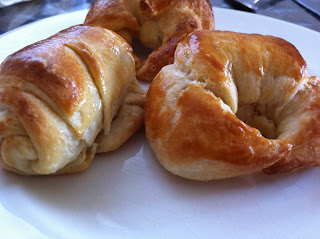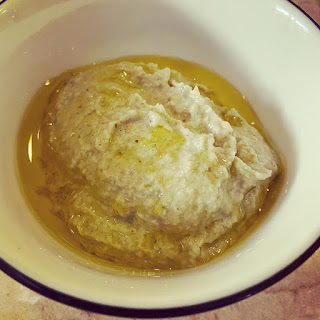Breakfast pastries
I made these this morning out of dough left over from a catering job, for which I made cinnamon whorl Danish pastries (sustenance for the adults attending a children's birthday party).
Most people, even pastry chefs, will look at you funny when you admit to making your own breakfast pastries. And I don't mean the Pillsbury ones you buy in a cardboard tube, or construct from ready-rolled puff pastry (not the same thing at all).
This is the real deal: sweet yeasted dough, rolled and folded to incorporate the (don't look now) tons of butter, rested, rolled and folded and then left to rest yet again. I won't lie to you, it's not a quick short-order meal ... but if you're in the kitchen anyway (I usually am) doing other things, then you won't notice the workload and the result is definitely worth the effort. It's really not difficult, or labour-intensive.
With sweet yeasted pastry dough the options are endless: basic straightforward croissants or the posher versions with almond paste (marzipan) or chocolate chips (or both) incorporated; the full range of Danish pastries - add dried or fresh fruit, jam, cinnamon butter, almond paste, flaked almonds, roll them or fold them - or go savoury with sausage rolls or a version of vol au vents to fill with pate ... am I admitting that I spend too much time thinking about these things?
As in the case of most things worth waiting for, you need to start well ahead of time. Why do you think bakers are up with the birds? This is my version of the recipe in Leith's Baking Bible, and I use my KitchenAid with dough hook attachment for the first stage.
Ingredients
For the pastry:
15g fresh yeast or half tsp dried active yeast
1tbsp caster sugar (if you want savoury pastry omit this and just use 1tsp to activate yeast)
110ml warm milk (body temperature, not scalding)
110g strong (bread) flour
110g plain (cake) flour
big pinch of salt (very important as you're using unsalted butter)
1 egg, beaten
110g unsalted butter, at room temperature (malleable, like playdough)
beaten egg to glaze
For the cinnamon butter:
100g soft, unsalted butter
1tbsp icing sugar
1tsp cinnamon
(Or marzipan, jam, flaked almonds, sultanas or raisins or glace fruit)
Method
Dissolve the yeast in 1tbsp of warm milk, with 1tsp of the sugar.
Put the flours and salt in a bowl, add remaining sugar (if using). Make a well in the middle, drop in the egg and the yeast mixture and, keep adding the milk while mixing the liquids and flour to make a soft dough. If necessary add more milk.
When the dough comes together and leaves the sides of the bowl, tip onto a floured work surface and knead until smooth.
Roll into a rectangle three times as long as it is wide. Fold loosely, wrap loosely in clingfilm and rest the dough for 30 minutes (in the fridge if the kitchen is very warm).
 Remove dough from fridge, unfold on a floured surface, and dot the butter evenly over the top two-thirds, leaving a 1cm margin round the edge. Fold the pastry in three, lengthwise, so you have a parcel. Turn it sideways, so the folds are in front of you, like a book (see left). Press the edges together and roll it out lengthwise using a rolling pin, until you again have a rectangle three times as long as it is wide. Fold in three as before. Chill for roughly 10 minutes (you don't want the butter to get too hard, so play this by ear. You can leave the pastry out of the fridge to rest or, if you leave it in the fridge for too long then let it warm up a bit before the R&F).
Remove dough from fridge, unfold on a floured surface, and dot the butter evenly over the top two-thirds, leaving a 1cm margin round the edge. Fold the pastry in three, lengthwise, so you have a parcel. Turn it sideways, so the folds are in front of you, like a book (see left). Press the edges together and roll it out lengthwise using a rolling pin, until you again have a rectangle three times as long as it is wide. Fold in three as before. Chill for roughly 10 minutes (you don't want the butter to get too hard, so play this by ear. You can leave the pastry out of the fridge to rest or, if you leave it in the fridge for too long then let it warm up a bit before the R&F). Repeat the rolling, folding and chilling 3 times more (mainly until you can't see blobs of butter through the top layer), then chill in the fridge overnight.
Repeat the rolling, folding and chilling 3 times more (mainly until you can't see blobs of butter through the top layer), then chill in the fridge overnight.Now you can roll it out and shape for croissants (cut into triangles and roll from the wide side), pain au choc (squares) or and shape for the Danish pastries of your choice.
For the cinnamon butter, make a paste with unsalted butter, icing sugar and ground cinnamon, smear on the rolled out pastry (with sultanas, glace fruit or anything else you want to add) then roll up like a swiss roll and cut into slices. Leave at room temperature on a baking sheet for 30 minutes to prove (see right), glaze with beaten egg and bake at 200C for 20-30 minutes.Voila!
 I don't think you need any instructions on how to eat them. My favourite is with more butter and set honey, lots of strong black coffee and the Sunday papers.
I don't think you need any instructions on how to eat them. My favourite is with more butter and set honey, lots of strong black coffee and the Sunday papers.


Comments
Post a Comment